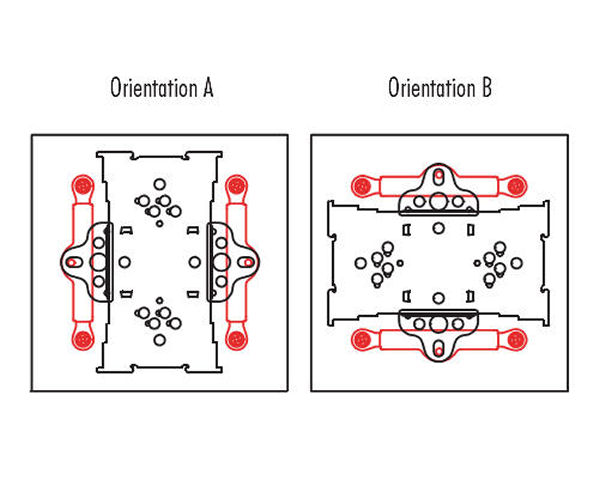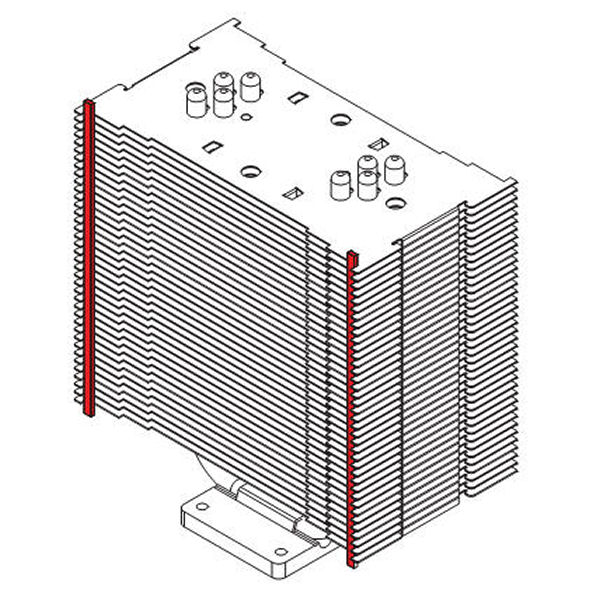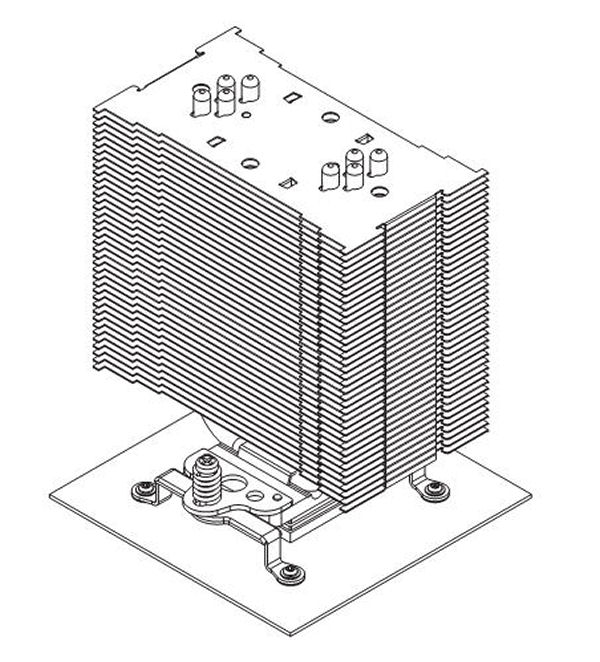Noctua NH-U12F: Quiet Air Cooling from Austria
by Wesley Fink on April 25, 2007 4:00 AM EST- Posted in
- Cases/Cooling/PSUs
Installation
The installation instructions for the Noctua are so good they should be a model for other cooler manufactures. Details and photographs are in the included manual and they are also available at the Noctua website. You first decide the mount kit you will use and then consider how you want the cooler to be oriented on the motherboard.
Noctua clearly spells out that the motherboard needs to be removed from the case to mount the cooler. For socket 775 the adapter mount can be attached with the mount holes in either direction.

You can use whichever configuration fits your board the best, since Noctua includes two sets of universal mount clips that allow any of the installations to be turned 90 degrees if necessary.

Universal mounting clips, which work with all mount adapters, are then screwed to the heatsink base. Shown are the standard universal mounts, but also included are optional horseshoe or u-shaped mounts, which install on the heatpipe sides and allow the Noctua cooler to be "turned" 90 degrees for mounting.

Self-adhesive elastomeric anti-vibration strips are then attached to the fan side mount(s) as shown.

For most configurations it is much easier to mount the heatsink to the motherboard before installing the fan(s). With the standard universal clips the fan covers the screw used for mounting. With the "horseshoe" shape mounts the supplied screwdriver fits the round holes near the end of the long direction of the heatsink. This allows mounting the cooler even though the heatsink covers the mounting screws.
All of this does not mean the mounting of the Noctua is any easier than some other heatsinks. Manipulating and aligning the under-the-board brace and the aboveboard washers/clips/screws is frankly a pain. The good news is that the only thing you need to install at that step are the small clips - not the huge heatsink. However, the clear instructions make a difficult task more bearable and there's a little less urge to throw things out the window.
While the Noctua NH-U12F is undeniably heavy and large, the back brace and very secure feel of the finished installation does inspire confidence that the cooler is not going to fall off the motherboard. However, as with any large and heavy cooler, you probably should avoid moving the mounted cooler around a great deal, as it could stress the board. None of the large heatpipe towers are really designed for a LAN party computer that is frequently transported.
UPDATE: Noctua has provided the following information on transporting the NH-U12F: "The mounting system of the NH-U12F was designed with LAN gamers in mind and we encourage users not to take the cooler off during transport. With many thousands of coolers sold, we haven't had one single problem from transporting a system with the Noctua cooler."










30 Comments
View All Comments
HeatMiser - Thursday, April 26, 2007 - link
Wes -- how far does this Noctua cooler hang over the edge of the motherboard closest to the Power supply? Just trying to figure out if I have room. Thanks for the great reviews on these coolers.Bumtrinket - Friday, May 4, 2007 - link
It largely depends on the motherboard - if the CPU socket is close to the top edge, you could have problems if there's not much space between the mobo and PSU. This also applies to the Thermalright Ultra 120 and other similar designs. The design of the heatsink mounting lets you rotate it through 90 degrees, but that's not the preferred orientation.There's more info at Noctua's site, but they say this in the FAQs:
"How much space between mainboard and power supply is required when the NH-U12 is installed upright?"
"When installed upright (see picture below), the NH-U12 may jut out over the upper edge of the mainboard. In this case, the gap required between the upper edge of the mainboard and the power supply in the case is (depending on the position of the CPU socket on the mainboard) up to 25mm. Measured from the upper mounting holes of the CPU socket, the required distance to the power supply unit is 35mm."
n7 - Wednesday, April 25, 2007 - link
I am a big fan of Noctua, so nice to see their heatsink do as well as i expected.Their fans are very good @ providing a mix of performance & realtive quietness, & it appears this heatsink is no different.
I too would really like to see a TT Big Typhoon added to the reviews, mainly to see how it does compared to the new leaders, something the Typhoon used to be.
I also look forward to seeing your testbed redone with a quieter PSU.
TA152H - Wednesday, April 25, 2007 - link
OK, I read this article with some interest, and as usual find the remarks about fanless power supplies completely off-base.I mean, if you're measuring overclocking a CPU, or some high end gaming system, or some high-end Peltier cooler, I could see the point in not using a fanless power supply because such a power supply wouldn't be useful in that configuration. But, I don't buy power supplies with fans anymore, and guess what type of heatsink I go after when I buy them? Yes, very quiet ones. So, when you're testing a heatsink/fan that is made to be especially quiet, or for example, fanless video cards, you SHOULD test with a fanless power supply.
I know most of the reviewers here think shooting space aliens is what everyone does, and they need 600 watt power supplies, but it's just not true. Most people in fact don't need anything that large, so try to think within the market of the product instead of personal preferences. I'm not knocking video games, by the way, they are a much better escape than drugs, or other bad things people do, or even TV. I'm just saying that you guys need to stop thinking everyone does this and needs equipment to handle these foul machines, especially when reviewing items that would never be put in one.
customcoms - Wednesday, April 25, 2007 - link
I agree that in order to get more accurate noise ratings a more quiet system based on a fanless psu would achieve higher accuracy. However, anandtech tests have generally catered to enthusiasts and overclockers, and imo, these tests do that well. For starters, they compare cooling performance with noise as a secondary consideration (mainly to see if the cooler advertised is quiet, but as it sates in the article, they are more curious about its cooling/overclocking ability than the noise). Yes, anandtech is using what could be considered a "noisy" test bed, but X6800's and 7900GTX's don't exactly come to mind when I think "silent" pc. Nor do the power, hungry, hot Nvidia 680i based boards. I suggest looking elsewhere for reviews on components that make up silent pc's, such as http://www.silentpcreview.com">http://www.silentpcreview.com. I'll stick with anandtech's review because I could care less about noise if it lets me gain an extra 300mhz out of my processor.TA152H - Wednesday, April 25, 2007 - link
Then why review a heatsink that is focused on being quiet? You completely missed the point. I don't have a problem with them reviewing noisy items, but you don't review a heatsink/fan that is made to be especially quiet, with a noisy power supply or video card. If the heatsink were a cooling beast that didn't pay much mind to noise problems, absolutely go with appropriate stuff. People that want it will not care about noise with the other components. But when someone is considering getting a unit because it is quiet, you don't use a noisy baseline because that same person is likely to look for that same quality in their other components.Ajax9000 - Wednesday, April 25, 2007 - link
Agreed.The "proper" (but time consuming :-) thing to do would be to have a "performance" testbed (which is also investigated for noise as a secondary test), and a "silent" testbed (which is also investigated for overclockability as a secondary test). I.e. people who want "quiet" systems don't automatically excude overclocking, they are just less concerned about it (and vice versa).
Paradox999 - Wednesday, April 25, 2007 - link
Great review and comparison.As an owner of a Scythe Ninja equipped with a silent fan, I can attest to it's effectiveness.....but your batch of reviewed HSF's is missing my personal favorite, the Thermaltake Big Typhoon. It's one of the best at cooling nearby capacitors since the fan blows DOWNWARDS onto the motherboard. I've replaced the original fans for some slower and silent Silenx fans since the core2duo isn't as hot as my old overclocked 820D.
Works awesome good.
Do us all a favor and please include the Big Typhoon (and not it's weaker cousin, the Mini Typhoon) in your review
Spanki - Wednesday, April 25, 2007 - link
I couldn't get my comments posted in here, so I added them as http://forums.anandtech.com/messageview.aspx?catid...">a new thread in the forums.Deusfaux - Wednesday, April 25, 2007 - link
"We also ran brief test results comparing the cooling efficiency and noise of the Scythe SFLEX SFF21F 64cfm/28 dB-A fan that was used in Thermalright reviews and the SilenX fan used in several of the most recent reviews. Cooling results were similar with either fan on the Noctua heatsink, with the SilenX providing better cooling on some overclocks. Both fans were quiet and came in below the noise floor of our test system, but the SilenX was subjectively quieter than the SFLEX. "REALLY. I have trouble believing this, but I guess we'll find out for sure in the upcoming roundup.